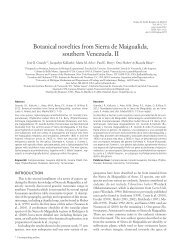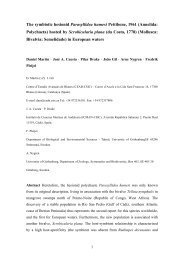Presence of raccoon (Procyon lotor) in Doñana National ... - secem
Presence of raccoon (Procyon lotor) in Doñana National ... - secem
Presence of raccoon (Procyon lotor) in Doñana National ... - secem
You also want an ePaper? Increase the reach of your titles
YUMPU automatically turns print PDFs into web optimized ePapers that Google loves.
X. Fernández-Aguilar et al.<br />
communication; Zone B, Figure 3). In this case there<br />
were some old footpr<strong>in</strong>ts, which probably were made<br />
at the end <strong>of</strong> previous spr<strong>in</strong>g. Just a day before, on<br />
04/09/2011, a <strong>raccoon</strong> was photographed <strong>in</strong> the<br />
“Marismillas” farm land <strong>in</strong> South-West <strong>Doñana</strong> NP,<br />
dur<strong>in</strong>g a camera trap campaign conducted by the<br />
<strong>Doñana</strong> NP monitor<strong>in</strong>g team (effort <strong>of</strong> 2077 traps<br />
/ night, Zone A, Figure 2 A and 3). Subsequent to<br />
these f<strong>in</strong>d<strong>in</strong>gs, many <strong>raccoon</strong> trails were found <strong>in</strong> a<br />
stretch <strong>of</strong> the Algarve stream, <strong>in</strong>cluded as SIC area<br />
(Sites <strong>of</strong> Community importance, 92/43/CEE) and<br />
located outside the <strong>Doñana</strong> protected areas (Figure<br />
1). This stretch, composed by riparian vegetation,<br />
extends from a wildlife underpass <strong>in</strong> the highway<br />
A49 up to 2.5 km to the South, follow<strong>in</strong>g the course<br />
<strong>of</strong> the stream (Zone C; Figure 3). Several camera trap<br />
devices were placed <strong>in</strong> six different locations <strong>in</strong> the<br />
same stream from 31/10/2011 to 02/12/2011. We<br />
used attractive lure for carnivores (“Gusto” Caven,<br />
M<strong>in</strong>nesota, USA) and sard<strong>in</strong>es <strong>in</strong> vegetable oil as<br />
bait. Graphic records <strong>of</strong> <strong>raccoon</strong>s were obta<strong>in</strong>ed <strong>in</strong><br />
two <strong>of</strong> these locations separated by 178 m, with a<br />
trapp<strong>in</strong>g effort <strong>of</strong> 24 traps /night (Figures 2 B and<br />
Figure 3).<br />
Figure 2. Raccoon images obta<strong>in</strong>ed by camera trapp<strong>in</strong>g,<br />
A: “Marismillas” farm land <strong>in</strong> the <strong>Doñana</strong> <strong>National</strong> Park<br />
(Zone A; Author: F. Alberto Carro); B: Algarve stream,<br />
just outside <strong>Doñana</strong> protected area (Zone C; Authors:<br />
G. Mol<strong>in</strong>a Vacas and X. Fernández Aguilar).<br />
Figure 1. H<strong>in</strong>d track (left) and front track (right) <strong>of</strong><br />
<strong>raccoon</strong>, with genet tracks (center). Recorded <strong>in</strong> the<br />
Algarve stream on 25/11/2011, just outside the <strong>Doñana</strong><br />
protected area (Zone C; Author: X. Fernández Aguilar).<br />
After confirm<strong>in</strong>g the presence <strong>of</strong> <strong>raccoon</strong>, on<br />
08/12/2011 was conducted a track<strong>in</strong>g survey <strong>in</strong><br />
22 po<strong>in</strong>ts distributed along 40 km <strong>of</strong> river course<br />
(<strong>in</strong> the Algarve and Cigüeña streams, and <strong>in</strong> the<br />
Guadiamar river) connect<strong>in</strong>g two <strong>of</strong> the zones <strong>of</strong><br />
<strong>raccoon</strong> presence (Zone B and Zone C, Figure 3).<br />
Two <strong>of</strong> these po<strong>in</strong>ts were positive on the presence<br />
<strong>of</strong> <strong>raccoon</strong> tracks (UTM time zone 29: 724274,<br />
4136750 and 726818, 4135080; Zone A Figure 3).<br />
Although results are <strong>in</strong>conclusive on the presence<br />
<strong>of</strong> more than one <strong>in</strong>dividual, this possibility should<br />
not be discarded regard<strong>in</strong>g available data about<br />
dispersion and home range (Rosatte 2000, Rosatte<br />
et al. 2007, Bartoszewicz et al. 2008, Puskas et<br />
al. 2011) and consider<strong>in</strong>g the spatio-temporal<br />
relationship <strong>of</strong> <strong>raccoon</strong> records (Zone A-C: 46.9 km,<br />
Zone A-B: 20 km; Zone B-C: 27.8 km). However,<br />
no <strong>raccoon</strong> records were obta<strong>in</strong>ed by the Iberian<br />
Lynx Conservation Team, which set up camera traps<br />
<strong>in</strong> suitable places for the Iberian Lynx Lynx pard<strong>in</strong>us<br />
(Temm<strong>in</strong>ck, 1827) along the whole <strong>Doñana</strong> area<br />
<strong>in</strong> 2011 (6.562 traps / night; L. Fernández & F. R.<br />
Martínez personal communication).<br />
S<strong>in</strong>ce no fur <strong>in</strong>dustries are present <strong>in</strong> the studied<br />
area, presumably, these <strong>in</strong>dividuals came from pets<br />
released <strong>in</strong>to the wild by its owners or by accidental<br />
escapes. To avoid more <strong>of</strong> these cases, the <strong>raccoon</strong><br />
has been <strong>in</strong>cluded <strong>in</strong> the list and catalog <strong>of</strong> <strong>in</strong>vasive<br />
alien species <strong>of</strong> Spa<strong>in</strong>, covered by the recently<br />
approved legislation “Real Decreto 1628/2011”,<br />
77
















